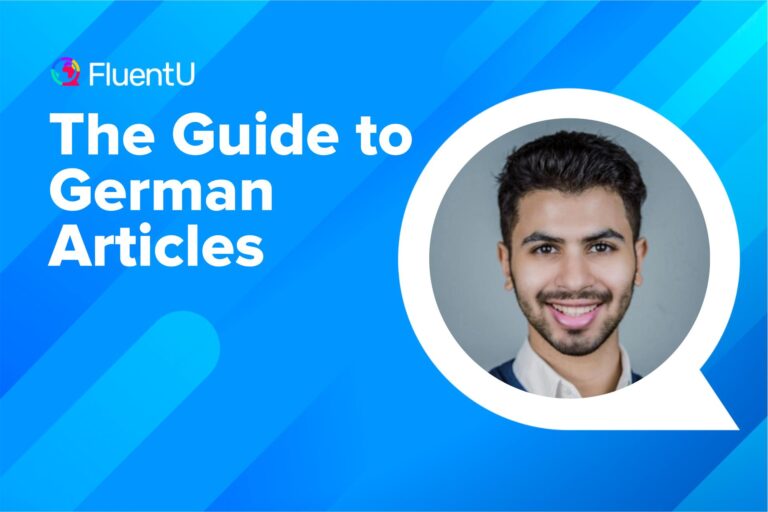Contents
Ein, Eine and Einen: The Guide to German Indefinite Articles

A cat, an apple—that’s basically all there is to English indefinite articles. But how can a word be so simple in English and yet so complicated in German?
German is notorious for tricky grammar, and the different ways of saying “a/an” (ein, eine and einen) seem to confirm this.
With that in mind, below is a simple and effective guide to figuring out when you should use ein, eine and einen.
Download: This blog post is available as a convenient and portable PDF that you can take anywhere. Click here to get a copy. (Download)
Indefinite Articles and German Cases
| Gender | Nominative Case | Accusative Case |
|---|---|---|
| Masculine | ein | einen |
| Feminine | eine | eine |
| Neuter | ein | ein |
German nouns are always one of three genders: masculine, feminine or neuter. A noun’s gender has little or nothing to do with the meaning of the noun itself. It is, however, one of the two elements that decide which definite or indefinite article goes before it.
The other element that decides the article of a noun is the part of the sentence that the noun represents; in other words, what the noun is doing. This is called what “case” the noun is in.
Is the noun the subject of the sentence and the person or thing that does the action? Is it a direct object that receives the action? These questions are important in determining the noun’s case, the other component that decides its article.
We’re only going to focus on the nominative and accusative cases here, as they will cover many of the sentences that beginning learners will use. As you continue your studies, you’ll also be introduced to the dative case, which is applied to indirect objects, as well as the genitive case, which is used to express possession.
The Nominative Case
The nominative case is used when the noun is the subject of the sentence, or the person or thing that does the action.
For example, in the sentence “A dog licks a boy,” the dog is the subject of the sentence, as it is doing the action of “to lick” and, therefore, in the nominative case.
The indefinite articles for the nominative case are as follows:
Masculine: ein
Example: Ein Frosch küsst die Prinzessin. (A frog kisses the princess.)
Feminine: eine
Example: Eine Frau isst den Kuchen. (A woman eats the cake.)
Neuter: ein
Example: Ein Buch liegt auf dem Tisch. (A book lays on the table.)
Notice that in each of the examples, the subjects—a frog, a woman and a book—are the “doers” of the sentence. They are committing the action and are, therefore, in the nominative case.
The Accusative Case
The accusative case is used when the noun is a direct object or, in other words, “receiving the action.”
The indefinite articles for the accusative case are as follows:
Masculine: einen
Example: Die Prinzessin küsst einen Frosch. (The princess kisses a frog.)
Feminine: eine
Example: Der Junge sieht eine Frau. (The boy sees a woman.)
Neuter: ein
Example: Der Mann malt ein Bild. (The man paints a picture.)
Notice how in these examples the frog, the woman and the house are all receiving the action and, therefore, are in the accusative case.
In addition, there are certain prepositions that always take the accusative. Some of the most important of these include für (for), durch (through), bis (until), um (around), ohne (without), entlang (along) and gegen (against).
So, after these articles you need to use the accusative case, like in this example using der Tunnel:
Wir fahren durch einen Tunnel. (We are driving through a tunnel.)
Definite Articles in the Nominative and Accusative
| Gender | Nominative | Accusative |
|---|---|---|
| Masculine | der | den |
| Feminine | die | die |
| Neuter | das | das |
Once you’ve mastered German indefinite articles in the nominative and accusative cases, it’s pretty easy to get them down for definite articles (ways of saying “the”) as well.
Like with indefinite articles, the definite articles are the same between the nominative and accusative cases, except for masculine nouns.
Nominative definite articles: der (masculine), die (feminine), das (neuter)
Example: Der Mann streichelt die Katze. (The man strokes the cat.)
Accusative definite articles: den (masculine), die (feminine), das (neuter)
Example: Der Hund sucht den Mann. (The dog is looking for the man.)
Tips for Mastering Ein, Eine and Einen
Now that you’re acquainted with German articles, here are a few tips to expedite the learning process and get you speaking and writing with ease.
Learn the Gender with the Noun
As we mentioned earlier, one way that German differs from English is that all nouns have a gender.
The gender of a noun is one of the determining factors in deciding which definite and indefinite articles are appropriate for a sentence.
When memorizing a noun, study it with its definite article (“the” in English) in the nominative case (der, die or das), as that will help you remember its gender and, therefore, which indefinite article is appropriate.
Take Advantage of Online Resources
With the advent of the internet, we now have more engaging ways to learn a language in context, even if we can’t travel to a German-speaking country.
If you need to look up a specific word or phrase involving indefinite articles, WordReference is a great online dictionary resource. This site gives ample examples alongside its definitions and even has discussion pages where you can ask native speakers for help when you aren’t sure about the best way to say something.
Connecting you to native speakers is one of the most important ways that the internet can boost your language learning. Even watching German content on YouTube can be a fun way to solidify everyday grammar and vocabulary in your head.
Further, you can also try the fun quizzes for practicing German indefinite articles offered by Sporcle, a popular quiz site.
Another resource for learning German in context is FluentU, an immersive language program.
FluentU takes authentic videos—like music videos, movie trailers, news and inspiring talks—and turns them into personalized language learning lessons.
You can try FluentU for free for 2 weeks. Check out the website or download the iOS app or Android app.
P.S. Click here to take advantage of our current sale! (Expires at the end of this month.)
Take Note of the Articles in Authentic German Texts
No matter how many rules a language may have, many of them can be picked up intuitively. The more you immerse yourself in the language, the easier it is to digest the grammar as it comes along.
When reading German (and do start reading it, no matter your level), keep an eye out for when ein, eine and einen are used. Eventually, you’ll be able to naturally distinguish between the cases, as well as to remember the gender of more nouns.
Even if you don’t live in Germany, there are a variety of ways to read in German. One of the country’s largest and oldest newspapers, Der Spiegel (The Mirror), can be viewed online for free.
News in Slow German is a site that offers the chance to read about currents events while highlighting tougher words so that you can view their translations. This site is helpful when reading for context, as well as when examining the use of indefinite articles.
The world would be an easier place if all languages had the same grammar rules and shared similar structures and it was simply a matter of switching vocabulary between them.
For better or worse, it takes a little more work than that to pick up a language, especially one that can, at times, have specific differences from English. Nonetheless, once you peek behind the curtain on grammar points such as selecting the appropriate indefinite articles, you’ll find that German isn’t that scary after all.
It often takes learning only a few simple rules to be on your way to fluency.
Download: This blog post is available as a convenient and portable PDF that you can take anywhere. Click here to get a copy. (Download)
And One More Thing...
Want to know the key to learning German effectively?
It's using the right content and tools, like FluentU has to offer! Browse hundreds of videos, take endless quizzes and master the German language faster than you've ever imagine!
Watching a fun video, but having trouble understanding it? FluentU brings native videos within reach with interactive subtitles.
You can tap on any word to look it up instantly. Every definition has examples that have been written to help you understand how the word is used. If you see an interesting word you don't know, you can add it to a vocabulary list.
And FluentU isn't just for watching videos. It's a complete platform for learning. It's designed to effectively teach you all the vocabulary from any video. Swipe left or right to see more examples of the word you're on.
The best part is that FluentU keeps track of the vocabulary that you're learning, and gives you extra practice with difficult words. It'll even remind you when it’s time to review what you’ve learned.
Start using the FluentU website on your computer or tablet or, better yet, download the FluentU app from the iTunes or Google Play store. Click here to take advantage of our current sale! (Expires at the end of this month.)













